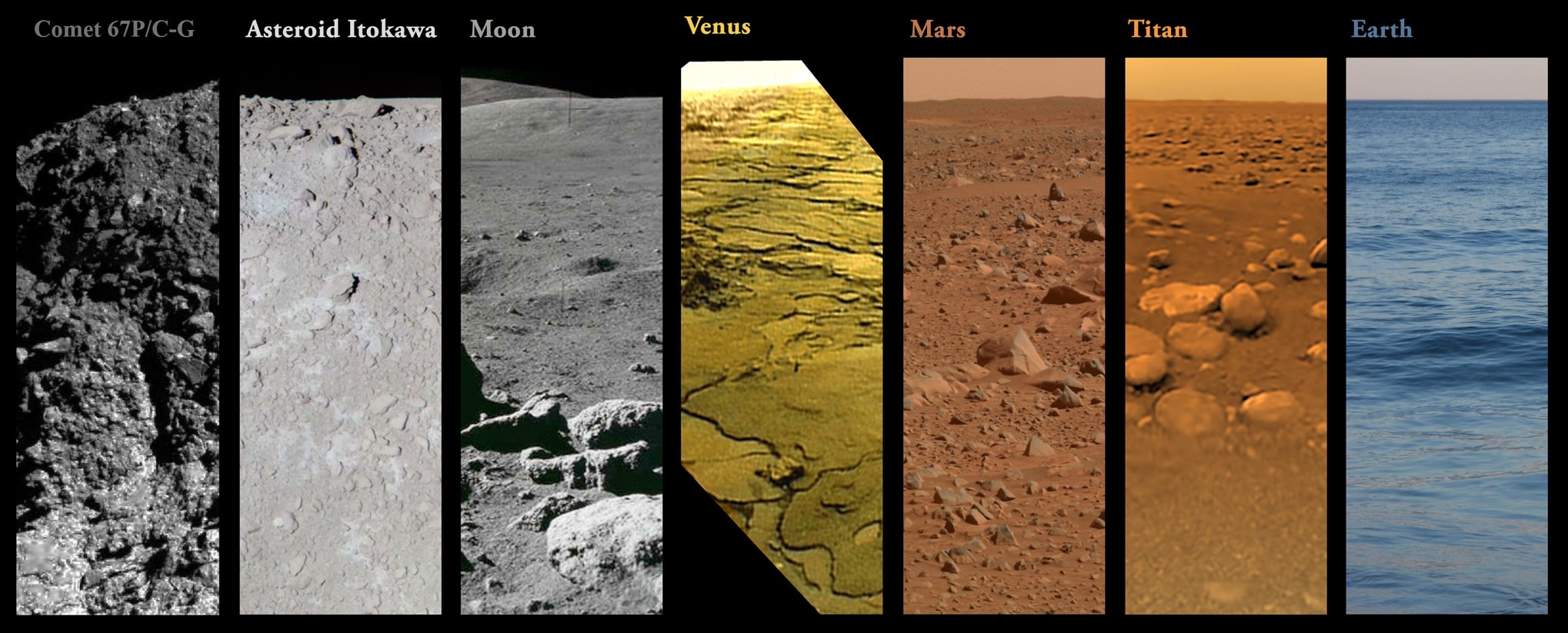Correction, 11:33 a.m. EST: The University of Central Florida’s Phil Metzger points out that the image composition leaves out Eros, which NEAR Shoemaker landed on in 2001. This article has been corrected to reflect that and to clarify that the surfaces pictured were from “soft” landings.
And now there are eight. With Philae’s incredible landing on a comet earlier this week, humans have now done soft landings on eight solar system bodies. And that’s just in the first 57 years of space exploration. How far do you think we’ll reach in the next six decades? Let us know in the comments … if you dare.
More seriously, this amazing composition comes courtesy of two people who generously compiled images from the following missions: Rosetta/Philae (European Space Agency), Hayabusa (Japan Aerospace Exploration Agency), Apollo 17 (NASA), Venera 14 (Soviet Union), the Spirit rover (NASA) and Cassini-Huygens (NASA/ESA). Omitted is NEAR Shoemaker, which landed on Eros in 2001.
Before Philae touched down on Comet 67P/Churyumov–Gerasimenko Wednesday, the NASA Jet Propulsion Laboratory’s Mike Malaska created a cool infographic of nearly every place we’ve lived or visited before then. This week, Michiel Straathof updated the infographic to include 67P (and generously gave us permission to use it.)
And remember that these are just the SURFACES of solar system bodies that we have visited. If you include all of the places that we have flown by or taken pictures from of a distance in space, the count numbers in the dozens — especially when considering prolific imagers such as Voyager 1 and Voyager 2, which flew by multiple planets and moons.
To check out a small sampling of pictures, visit this NASA website that shows some of the best shots we’ve taken in space.


None of these look like “ice” to me.
No because they mostly rock (Moon, Venus, Mars, Itokawa) with one water (Earth), one tholin covered ice (Titan) and another a rocky dirty ice mixture! (Comet Churyumov-Gerasimenko aka 67P) So?
Earth – 182x (?)
Moon – 1966
Mars – 1971
Venus – 1975
Titan – 2005
Itokawa – 2005
67P/C-G – 2014
I’m sure in 60 years from now they’ll be more than 14. The only problem is that they’re all very far away, unless we start colonies closer to those places or send several landers at once, the numbers will keep growing sowly…
Hopefully bythen there’ll be a similar panel with photos taken by people and not just by probes 🙂
We are actually up to 8 already. The NEAR Shoemaker spacecraft landed on asteroid 433 Eros 🙂
February 12, 2001
Landing of NEAR spacecraft on asteroid Eros
http://en.wikipedia.org/wiki/NEAR_Shoemaker
The thing is, we’ve landed on most of the easy ones already. Governments show little enthusiasm for funding projects that will take multiple decades to get any new results. I do expect landings on the major satellites of Jupiter and Saturn by then, probably another few asteroids and comets. Landings on Triton, a Kuiper belt object, or Mercury might happen but are long shots.
my understanding was that the Itokawa image was taken from above the surface ( several thousand meters ) and there arent images from after landing on it’s surface.. though it was a soft landing. the rest of the surfaces above we have imagery FROM the surface..
Mine too at first – except they did have a sample return capsule thingy that did collect a few particles by sort of bumping into briefly so maybe that counts!
Eros was landing for the NEAR-Shoemaker spacecraft so I think maybe they could have substituted that for Itokawa? However, yeah, it was a harder landing as noted. Also not sure it actually imaged from the surface itself just the moments leading up to it. (I could be wrong there -would have to check and so feel free to correct me on this.) Thus I can see the logic here. Sort of anyhow.
venus is my fav. so… deadly.
“How far do you think we’ll reach in the next six decades?”
Not sure but plenty of hopes! Six decades takes us out to 2075 which is quite a while!
I’d expect Phobos & Deimos – the martian moonlets, maybe Mercury and a few other asteroids.
Perhaps also Pluto, Triton, Europa, and some of the other Jovian and Saturnian, Ouranian* and Neptunean moons as well. Jupiter has radiation issues and Io has vulcanism as major obstacles but also fascinating large worlds.
I’d love to see that and more!
* As the only planet named for a greek God rather than its roman equivalent I prefer to use the accurate greek spelling of Ouranos for the “sideways planet” also known as Georgium Siderus and 34 Tauri among other things!